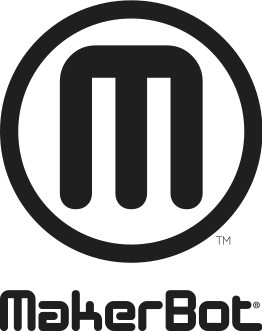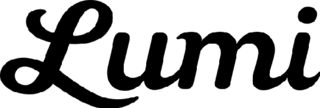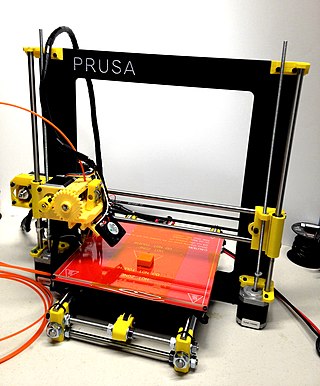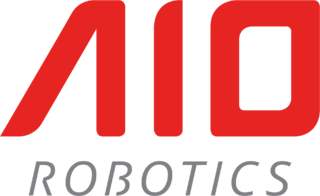
RepRap is a project to develop low-cost 3D printers that can print most of their own components. As open designs, all of the designs produced by the project are released under a free software license, the GNU General Public License.

Stratasys, Ltd. is an American-Israeli manufacturer of 3D printers, software, and materials for polymer additive manufacturing as well as 3D-printed parts on-demand. The company is incorporated in Israel. Engineers use Stratasys systems to model complex geometries in a wide range of polymer materials, including: ABS, polyphenylsulfone (PPSF), polycarbonate (PC) and polyetherimide and Nylon 12.

MakerBot Industries, LLC was an American desktop 3D printer manufacturer company headquartered in New York City. It was founded in January 2009 by Bre Pettis, Adam Mayer, and Zach "Hoeken" Smith to build on the early progress of the RepRap Project. It was acquired by Stratasys in June 2013. As of April 2016, MakerBot had sold over 100,000 desktop 3D printers worldwide. Between 2009 and 2019, the company released 7 generations of 3D printers, ending with the METHOD and METHOD X. It was at one point the leader of the desktop market with an important presence in the media, but its market share declined over the late 2010s. MakerBot also founded and operated Thingiverse, the largest online 3D printing community and file repository. In August 2022, the company completed a merger with its long-time competitor Ultimaker. The combined company is known as UltiMaker, but retains the MakerBot name for its Sketch line of education-focused 3D printers.
Printrbot is a 3D printer company created by Brook Drumm in 2011 and originally funded through Kickstarter. Printrbot printers use fused deposition modelling to manufacture 3-dimensional artifacts.
Construction 3D Printing (c3Dp) or 3D construction Printing (3DCP) refers to various technologies that use 3D printing as a core method to fabricate buildings or construction components. Alternative terms for this process include "additive construction." "3D Concrete" refers to concrete extrusion technologies whereas Autonomous Robotic Construction System (ARCS), large-scale additive manufacturing (LSAM), and freeform construction (FC) refer to other sub-groups.

Lumi is a Los Angeles–based company founded by Jesse Genet and Steph Ango that offers packaging and supply chain management software. The company got its start developing Inkodye, a photo-reactive vat dye that develops its color through exposure to UV or sunlight.

Solidoodle was a 3D printer company headquartered in Brooklyn, New York. Solidoodle was founded in September 2011 by engineer Sam Cervantes. Solidoodle 3D printers use digital files supplied by the user to create physical plastic parts.
ROBO 3D was an American 3D printer manufacturer located in San Diego, California and traded in Australian Securities Exchange under symbol ASX: RBO.
A recyclebot is an open-source hardware device for converting waste plastic into filament for open-source 3D printers like the RepRap. Making DIY 3D printer filament at home is both less costly and better for the environment than purchasing conventional 3D printer filament. In following the RepRap tradition there are recyclebot designs that use mostly 3-D printable parts.

M3D, LLC is an American manufacturer of 3D printers in Fulton, Maryland. The company's flagship product is the "Micro 3D" or "Micro".
This article contains a list of 3D printers.
Zortrax is a Polish manufacturer of 3D printers and filaments for SMB market and rapid prototyping for industries, including robotics and automation, architecture, industrial design, engineering, aviation, industrial automation. Zortrax machines work with dedicated software, firmware and filaments.

Fused filament fabrication (FFF), also known as fused deposition modeling, or filament freeform fabrication, is a 3D printing process that uses a continuous filament of a thermoplastic material. Filament is fed from a large spool through a moving, heated printer extruder head, and is deposited on the growing work. The print head is moved under computer control to define the printed shape. Usually the head moves in two dimensions to deposit one horizontal plane, or layer, at a time; the work or the print head is then moved vertically by a small amount to begin a new layer. The speed of the extruder head may also be controlled to stop and start deposition and form an interrupted plane without stringing or dribbling between sections. "Fused filament fabrication" was coined by the members of the RepRap project to give an acronym (FFF) that would be legally unconstrained in its use.
Fusion3 is a Greensboro, North Carolina company which manufactures 3D printers for commercial and education use. Fusion3 3D Printers use fused deposition modeling to create three-dimensional solid or hollow objects from a digital model, which can be designed or produced from a scan.

AIO Robotics is a Los Angeles, California-based company that produces 3D printer and 3D scanner technology.

The Prusa i3 is a family of fused deposition modeling 3D printers, manufactured by Czech company Prusa Research under the trademarked name Original Prusa i3. Part of the RepRap project, Prusa i3 printers were called the most used 3D printer in the world in 2016. The first Prusa i3 was designed by Josef Průša in 2012, and was released as a commercial kit product in 2015. The latest model is available in both kit and factory assembled versions. The Prusa i3's comparable low cost and ease of construction and modification made it popular in education and with hobbyists and professionals, with the Prusa i3 model MK2 printer receiving several awards in 2016.

Cura is an open source slicing application for 3D printers. It was created by David Braam who was later employed by Ultimaker, a 3D printer manufacturing company, to maintain the software. Cura is available under LGPLv3 license. Cura was initially released under the open source Affero General Public License version 3, but on 28 September 2017 the license was changed to LGPLv3. This change allowed for more integration with third-party CAD applications. Development is hosted on GitHub. Ultimaker Cura is used by over one million users worldwide and handles 1.4 million print jobs per week. It is the preferred 3D printing software for Ultimaker 3D printers, but it can be used with other printers as well.

A variety of processes, equipment, and materials are used in the production of a three-dimensional object via additive manufacturing. 3D printing is also known as additive manufacturing, because the numerous available 3D printing process tend to be additive in nature, with a few key differences in the technologies and the materials used in this process.
Marlin is open source firmware originally designed for RepRap project FDM 3D printers using the Arduino platform.
Liquid additive manufacturing (LAM) is an additive manufacturing technique which deposits a liquid or high viscosity material (e.g Liquid Silicone Rubber) onto a build surface to create an object which then vulcanised using heat to harden the object. The process was originally created by Adrian Bowyer and was then built upon by the company German RepRap.










